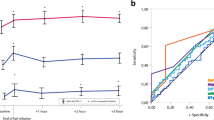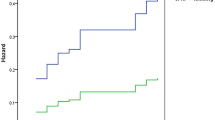Summary
The aim of this study was to assess the hemodynamic response to intravenous atenolol in elderly patients with acute myocardial infarction. We studied 14 elderly men, aged 64–85 years, and 14 younger men, aged 29–48 years, in the early postfibrinolytic phase of acute myocardial infarction. All the patients were in Killip class I. A triple-lumen Swan-Ganz thermodilution catheter was introduced into the right heart chambers. The patients received 5 mg intravenous atenolol over 5 minutes. All hemodynamic parameters were measured before and 10 minutes after atenolol. The hemodynamic characteristics and the location and extent of acute myocardial infarction were the same in both groups before atenolol. The hemodynamic changes after atenolol administration were the same in the two groups, but the stroke volume and cardiac indexes decreased to a greater extent in the elderly (p=.01 and p=.0001, respectively). These results indicate that intravenous atenolol in the early postfibrinolytic phase of acute myocardial infarction is safe in Killip class I elderly patients, although the cardiac and stroke volume indexes decrease, and the increase in the total systemic resistance is more in older than in younger patients.
Similar content being viewed by others
References
Schocken DD, Roth GS. Reduced beta-adrenergic receptor concentrations in aging man. Nature 1977;4:856–858.
Vestal RE, Wood AJJ, Shand DG. Reduced beta-adrenoreceptor sensitivity in the elderly. Clin Pharmacol Ther 1979;26:181–186.
Dillon N, Chung S, Kelly J, O'Malley K, et al. Age and beta adrenoreceptor mediated function. Clin Pharmacol Ther 1980;27:769–772.
Kyriakides ZS, Kelesides K, Melanidis J, et al. Systolic functional response of normal older and younger adult left ventricles to dobutamine. Am J Cardiol 1986;58:816–819.
Rich MW, Imburgia M. Inotropic response to dobutamine in elderly patients with decompensated congestive heart failure. Am J Cardiol 1990;65:519–521.
Yin FCP, Raises GS, Guarnieri T, et al. Age-associated decrease in ventricular response to haemodynamic stress during beta-adrenergic blockade. Br Heart J 1978;40: 1349–1355.
Lake CR, Ziegler MG, Coleman MG, Kopin IJ. Age-adjusted plasma norepinephrine levels are similar in normotensive and hypertensive subjects. N Engl J Med 1977;296: 208–209.
Gutteberg T, Borud O, Stromme JH. Dopamine-β-hydroxylase activity in serum following acute myocardial infarction: An evaluation of this parameter for routine use as an index of sympathetic activity. Clin Chim Acta 1976;69:61–66.
The MIAMI Trial Research Group. Metoprolol in acute myocardial infarction (MIAMI). A randomised placebocontrolled international trial (with discussants). Eur Heart J 1985;6:199–226.
ISIS-1 (First International Study of Infarct Survival) Collaborative Group. Randomised trial of intravenous atenolol among 16027 cases of suspected acute myocardial infarction: ISIS-1. Lancet 1986;2:57–65.
Hindman N, Grande P, Harrel FE, et al. Relation between electrocardiographic and enzymatic methods of estimating acute myocardial infarct size. Am J Cardiol 1986;58:31–35.
Proper R. Left ventricular stroke volume measurements not affected by chronologic aging. Am Heart J 1972;83:843–845.
Greenblatt DJ, Koch-Weser J. Adverse reactions to propranolol in hospitalized medical patients: A report from the Boston Collaborative Drug Surveillance Program. Am Heart J 1973;88:478–484.
Castleden CM, Kaye CM, Parsons RL. The effect of age on plasma levels of propranolol and practolol in man. Br J Clin Pharmacol 1975;2:303–306.
Kendall MJ, Brown D, Yates RA. Plasma metoprolol concentrations in young, old, and hypertensive subjects. Br J Clin Pharmacol 1977;4:497–499.
Schneider R, Bishop H, Yates RA, et al. Effect of age on plasma propranolol levels (letter). Br J Clin Pharmacol 1980;10:169–170.
Regardh CG, Landahl S, Larsson M, et al. Pharmacokinetics of metoprolol and its metabolite alpha-hydroxy metoprolol in healthy, nonsmoking elderly individuals. Eur J Clin Pharmacol 1983;24:221–226.
Author information
Authors and Affiliations
Rights and permissions
About this article
Cite this article
Kyriakides, Z.S., Kremastinos, D., Karavolias, G. et al. Intravenous atenolol in elderly patients in the early phase of acute myocardial infarction. Cardiovasc Drug Ther 6, 475–479 (1992). https://doi.org/10.1007/BF00055604
Issue Date:
DOI: https://doi.org/10.1007/BF00055604




